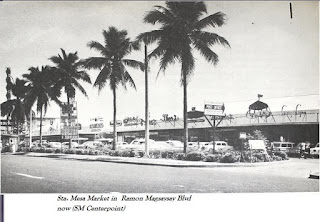The border between Sta.
Mesa, Manila and the city of San Juan, where SM Sta. Mesa now stands, is a
unique place that stands at the cusp of historical eras and physical landmarks
of the metropolis. It is a key section of Manila’s storied Sampaloc district and
its stories are begging to be told.
Sampaloc gets its name
from the tamarind trees that lined and shadowed its streets; at least back in
the Spanish colonial era. Like the rest of Manila, the district of Sampaloc
proffers two, or actually several, faces. On one side, it is teeming with
shops, markets, the University Belt, and rows of rundown apartments, or accessorias.
On the other end (where SM Sta. Mesa sits) it was a residential quarter that is
evocative of a more quiet and refined past; and now, a promising urban future.
Manila’s
third district enjoys a wide embrace, from the San Juan River and the stone
bridge that Sta. Mesa crosses, to the Pasig river at Nagtahan, and on to the
boundaries of the districts of San Miguel, Quiapo and Santa Cruz.
·
Magsaysay
Avenue, as it looked in the ‘50s, had problems with jaywalkers.
Sampaloc was founded by
Franciscan priests in 1613. Here, they built a church to Nuestra Señora de
Loreto on what is now Bustillos Street. As they did, the new parish church set
the point from which the township was going to radiate, as was typical in most
towns.
But Sampaloc proved to
be not quite so typical because, curiously, in 1783 the Franciscans ordered the
relocation of another church, the Church of St. Anthony of Padua from its
original location in Paco to a parcel of land just off Calle Bustillos. It
faces off with the Church of Our Lady of Loreto, and now acts seemingly as a
second parish church to the locale.
·
Sta.
Mesa was the site of ‘50s suburban development because of its proximity to
central Manila.
Up until the early
American period, Sta. Mesa was just one of the barrios that comprised the
Sampaloc district. In 1911, it achieved a status of being a separate religious
district, and divided Sampaloc into two parishes. The newly created parish is
now known as the Old Sta. Mesa, which extended from V. Mapa to Sta. Mesa
Boulevard.
The neighborhood was composed
of wealthy Spanish and Filipino families who built summer houses attracted to
Sta.Mesa’s cool climate and the picturesque streets that were lined with ilang-ilang trees.
So numerous were the trees that it was not for long until it became an industry
— flowers were harvested, pressed and the oil were exported in great quantities
to perfumeries in France.
In 1881, shortly after
its relocation, the Manila Jockey Club once again opened its doors and resumed
horse racing in the Sta. Mesa Hippodrome, in the street that now bears the same
name. For four days during racing season, everything was at a standstill, and
everyone in town, from the governor to the archbishop to the elite, the expats
down to the market vendors attended these racing events.
Sta. Mesa is also known for a beautiful
landmark, the Carriedo Waterworks Fountain; named after the Spanish
philanthropist, Don Francisco Carriedo y Peredo, who made it his life mission
to bring potable water to city of Manila. Up until 1878, Manila had no running
water, and the population looked to the rivers and estuaries as the chief
source of water.
·
The
original Sta. Mesa market was originally planned with a skyscraper at the rear.
Donating P10,000, which
even at the time was a sizeable amount, a municipal waterworks was established
by Gov. Domingo Moriones. Upon completion, the water system was then able to
deliver 16 million liters of water per day to 300,000 people. A fountain was
built in honor of this event and the man that made it possible. It was located
at the point where Sta. Mesa Boulevard, Aviles, Nagtahan and Legarda Streets
converged.
In the 1970s, the
fountain was transferred to Plaza Sta. Cruz where it remains to this day but
not after a replica of the fountain was made by National Artist Napoleon Abueva
and brought to the water treatment plant in Old Balara in Quezon City.
Incidentally, Francisco Carriedo did not just bring us water, he also lent his
name to the street in Manila where the original Shoemart was located.
In the 1950s, plans to
revamp Sta. Mesa were under way, and the construction of the new Sta. Mesa
market ensued. It was a big shopping complex, and was popular for the selling
of PX goods. The shops were laid out in straight rows, with almost no end in
sight. A tall building for offices was planned at the rear overlooking the San
Juan bridge, but it was never constructed. The biggest attractions in the
market were an indoor skating rink and hobby shops featuring slot cars and
remote controlled miniature planes.
·
The Carriedo fountain at the turn of the century was a prominent
landmark north of Malacañang.
Today, Sta. Mesa has
come a long way from being just a sleepy barrio. It has risen to become one of
the busiest sections of the city …every bit as urban as the rest. It is now a
confluence of modernity and history, high-rise buildings and a popular mall but
still retaining the character of the old district and its small town heartland.





No comments:
Post a Comment